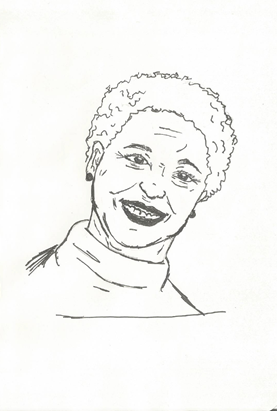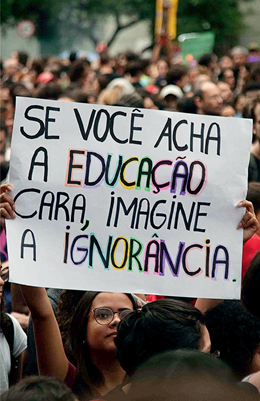by Viviane Gonçalves Freitas
Translated by Anna Bennech Reviewed by Matheus Lucas Hebling
Originally published in Portuguese May 20, 2020 link
On March 11th, the World Health Organization (WHO) decreed the new coronavirus pandemic. Eleven days later, the first victim of Covid-19 died in Brazil: she was a black 63 years old woman, a domestic worker, hypertensive, diabetic. She used to work at Leblon and live in Miguel Pereira, in Rio de Janeiro. Marcelo Crivella, the mayor (Republicans), decreed the quarantine for the entire carioca population on the same day, and it would begin on the following Tuesday, March 24th. At that time, there was information that the Brazilian reported contagion cases were still “imported,” and travelers should quarantine. Still, Cleonice Gonçalves was cooking at her employer’s house. The employer returned from Italy, bringing in the luggage much more than pleasant trip memories. Unfortunately, this is not an isolated case. The situation repeats in several news reports, to the point that many believe that the Covid-19 was just a “disease of rich people, who traveled abroad.”
The new coronavirus pandemic highlighted inequalities and posited privileges wide open. It may be another of several concretizations of necropolitics, a concept elaborated by the Cameroonian political theorist Achille Mbembe. Necropolitics would be the repercussion of decision-making on the sovereignty of death, the decision about who should live and who can die. In this context, death is the condition of invisibility, denial, and non-existence.
With the recommendations for social isolation in force, the inequalities of race, class, and gender presented themselves blatantly. Who can do the home office? Who can buy the basics to survive among an economic crisis that deepens every day? Who can follow the rules of constant hygiene with water and soap, alcohol gel, and social distance inside and between households? Who can access adequate care with appropriate timing to avoid a health condition worsening or even death? Who is responsible for the highest part of taking care of the house chores, the elderly, and children amid the pandemic?
Among the activities with the highest concentration of women in Brazil, domestic work is one of the most significant. Women represent 90% of the more than 6 million people in this activity, 60% of whom are black. The absence of fundamental rights for many informal workers is constant in daily life. These people depend on public transportation to reach the homes and companies they do the cleaning and receive for the day of service. Often considered invisible, the employers feel the lack os these people when clothes accumulate without washing or ironing, food is not ready in the refrigerator, the child gets in the way of a work meeting, or there is dust on the living room shelf. During the current situation, many domestic workers return to their jobs, which puts at risk the various rights acquired with the Domestic Law (Complementary Law 150/2015).
Only after 15 weeks of daily epidemiological bulletins, the Ministry of Health, still under the management of Luiz Henrique Mandetta (Democrats), released, for the first time, data on the number of infected people and deaths by Covid-19, with the identification of race/color. According to the information presented on April 10th, black and brown people accounted for 23.1% of hospitalizations for Severe Acute Respiratory Syndrome (SARS) by Covid-19 and 32.8% of deaths due to the disease. Among the white population, the percentages were 73.9% for hospitalizations and 64.5% for deaths. Experts pointed out that there was still much influence from the first wave of contamination, when the majority of cases were people returning from abroad, besides the possibility of underreporting, since some cities and states were submitting only the most severe cases to public testing. It is also crucial to note that such information excluded almost 2,000 cases of hospitalizations and about 340 deaths, whose race/color variable was not informed.
Two months after the first data, the Ministry of Health, on occasion coordinated by Nelson Teich, reported, on May 8th, the following percentages according to race/color on hospitalizations due to SARS by Covid-19: white (54.7%), brown (36.3%) and black (6.8%), excluding approximately 10,400 cases whose race/color variable was ignored. As for the deaths, 47.7% were white; 42.7% were black, and 7.4% were brown, except that in almost 2.9 thousand deaths, the variable race/color was ignored and excluded from the analysis.


As there is still no scientific evidence that mortality due to Covid-19 infection is associated with race/color, experts believe that other factors linked to socioeconomic and racial inequalities could aggravate lethality among the black population. Lack of basic sanitation, poor housing conditions, and poor diet are examples. Less access to treatment and a higher incidence of commodities (hypertension, diabetes, tuberculosis, among others) could contribute significantly.
These data were compiled and disseminated with a racial perspective only because the Black Coalition for Rights filed requests with the Ministry of Health and state-level health secretariats for information to be broken down by ethnicity, race, gender, and territory (city and neighborhood). One hundred fifty entities representing the black movement and the Brazilian peripheries, and the Black People’s Health Working Group of the Brazilian Society of Family and Community Medicine (SBMFC) compose the Black Coalition for Rights. The objective was to profile the most affected people and demand public policies that contemplate them. According to the Ministry of Health, almost 80% of SUS users are black.
Once again, Covid-19 reminds us that inequalities are re-edited around the world. In New York, the disease epicenter in the United States, a survey conducted in early April indicated that the new coronavirus was twice as lethal among the Latin and black population as among white people. For the mayor, Bill de Blasio, the disparity reflected the distant and persistent economic inequalities and differences in access to health care. Another US example: in Louisiana, one of the most affected states, on April 9th, 70% of the dead were black, even though this portion represented one-third of the state’s inhabitants.
According to Johns Hopkins University and WHO, on April 8th, there were 10,655 registered cases of contamination and 532 deaths, not ruling out the possibility of under reporting. In one week, confirmed cases of Covid-19 more than doubled (on March 30th, there were 4,718 contaminations) and almost quadrupled the number of deaths (on March 30th, 152 deaths). By way of comparison, after the first month, Italy had 1,694 confirmed cases and 29 deaths; in Brazil, the numbers reached 1,468 infected and four deaths in the first thirty days. In a study released by the WHO, one month later (May 7th), if the confinement measures fail in the 47 countries of the African continent contemplated by the research, between 83 thousand and 190 thousand people may die from Covid-19. Moreover, between 29 million and 44 million may be infected during the first year of the pandemic.
Viviane Gonçalves Freitas holds a post-doc in Political Science (UFMG), a Ph.D. in Political Science (UnB), and is currently a member of the Research Network on Feminisms and Politics and the Margin – Democracy and Justice Research Group. E-mail: vivianegoncalvesfreitas@gmail.com.








